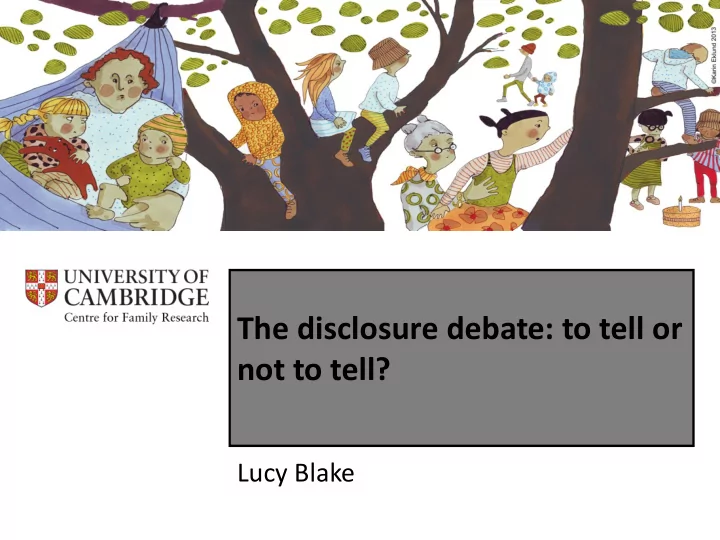

The disclosure debate: to tell or not to tell? Lucy Blake
Lecture Outline Aim: context and complexity – 1. Disclosure in context: who uses reproductive donation, why is non-disclosure an issue? – 2. History/ culture of disclosure: Roots of non- disclosure. – 3. Family perspectives: parents and children’s perspectives.
1. Why is this debate important? Parents, children, families : • HFEA 2009: approx. 1700 children conceived using donated sperm or eggs. • Children conceived outside of a clinical setting: facebook groups, Prideangel. • Reproductive donation: global industry • Anger and protest: ‘Tangled Webs UK’ Family policy • Access to ART • Donor anonymity • Birth certificates
1. Who uses donors and why? Who uses donated sperm, eggs, embryos? Heterosexual couples , lesbian mothers, gay fathers, single men, single women Why do people use donors? • Infertility ( medical/ social) • Avoid passing on genetic disorder • Avoid passing on sexually transmitted disease • Irreversible vasectomy Focus: heterosexual couples DI medical infertility
1. What is disclosure? What do we talk about when we talk about disclosure? • Children conceived using donated sperm , eggs of embryos. • Parent’s decisions to tell their children that they lack a genetic relationship with one or both parents. • Parents’ decisions to tell their children that they are genetically related to a donor.
1. Rates of disclosure in the UK: non-disclosure Sperm donation Egg donation Told 12 (38%) 17 (63%) Plans to tell 3 (9%) 3 (11%) Plans not to tell 15 (47%) 3 (11%) Uncertain 2 (6%) 3 (11%) Total 32 27 * Children conceived using anonymous donors * Complexities: differences and similarities between sperm and egg donation often lost.
1. Concerns: non-disclosure • Adoption literature – secrecy and shame to openness, ‘genealogical bewilderment’ • The Family Therapy Literature – division, obsession, dichotomy of good or bad • Bioethics and philosophy - identity
1. Concerns: non-disclosure “When adoptees go in search of their biological parents and siblings, there is a literal sense in which they are searching for themselves. They are searching for the closest thing to a mirror in which to catch an external and candid view of what they are like in more than mere appearance. Not knowing any biological relatives must be like wandering in world without reflective surfaces, permanently self- blind.” Velleman, 2005, Family History
2. The culture of disclosure … Forget signed papers. If the patients are carefully selected, contracts and agreements are unnecessary, and simply act as a permanent reminder of something which should be forgotten as quickly and completely as possible . In the ideal case, by the time the patient reaches term, the woman, the husband and the doctor have to think twice to remember that the pregnancy is physically not the husband’s for psychically it has become his . (Guttmacher, 1943, p. 589-590)
2. The culture of disclosure British man 'fathered 600 children' at own fertility clinic
2. The culture of disclosure “It would be impossible to answer all the letters on this subject … Moreover, as many of these letters contain nothing but abuse, it would be unprofitable to answer them… the results have been very disappointing. The scientific aspects of insemination have aroused no interest, and the whole subject has been summarily dismissed as immoral by many.” (Barton et al., 1945)
Who’s your daddy?
2. Culture “in transition” 1940s 1950s 1960s 1970s 1980s 1990s 2000 2010….. Non-disclosure encouraged Donor anonymity Disclosure encouraged Open-identity donors Donor Sibling Registry
Disclosure
Disclosure
Children’s Understanding Age 7 “She [Mum] had the eggs put into her and then my dad’s sperm mixed it up and, and then I got created, and then she said like, about all the particles run about and make stuff. And, she doesn’t know who it is, she, it was about her age or something …that’s all I really know, I don’t know too much. ” (ED) “Daddy couldn’t produce a seed, so another man had to give a seed that will make the baby. ” (DI) “I slept in my tummy instead of her tummy? I got put in a freezer? She gave Mum something, what was it?” (ED)
3. Children’s Perspectives: Age 14 Questions for the donor Why did he donate? What are his hobbies/ interests? How old was he when he donated? Where is he from? How is he? Does he have children of his own? Is he aware of any other donor offspring? Does he donate often? Don't know.
Complexity: What is disclosure? – Was the donor anonymous, identity-release or known donor? – Who else knows about the use of a donor in the family? – Who else outside of the family knows? – How were my siblings conceived? – What information do parents have about the donor? – Did parent/s conceive in a clinic? – Did parents conceive in the UK or elsewhere? – Do I have donor siblings? – Are my donor siblings interested in being contacted?
Summary • Disclosure is a layered family process . • The cultural context in which reproductive donation has changed over time and continues to change. • Parents’ perspectives: diverse and change over time. “we’re just a normal family” • Children’s perspectives: important piece of the puzzle “it’s just ordinary really”. Children react to disclosure in neutral ways, not a problematic in adolescence. – What if they want to meet him/ her by they can’t? – Vital to consider context, nature of sample, etc.
Recommend
More recommend